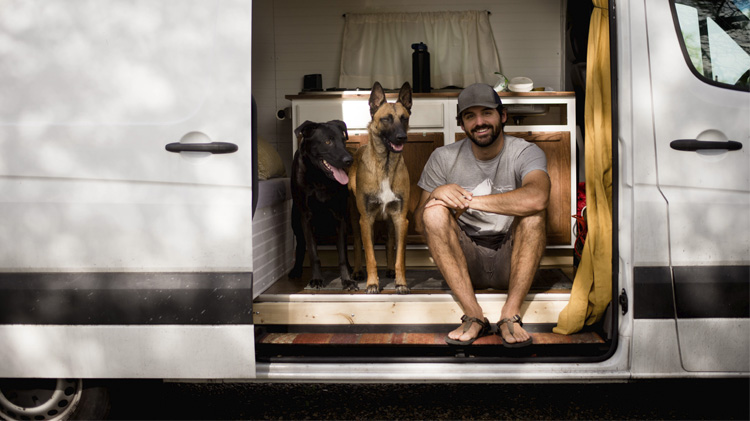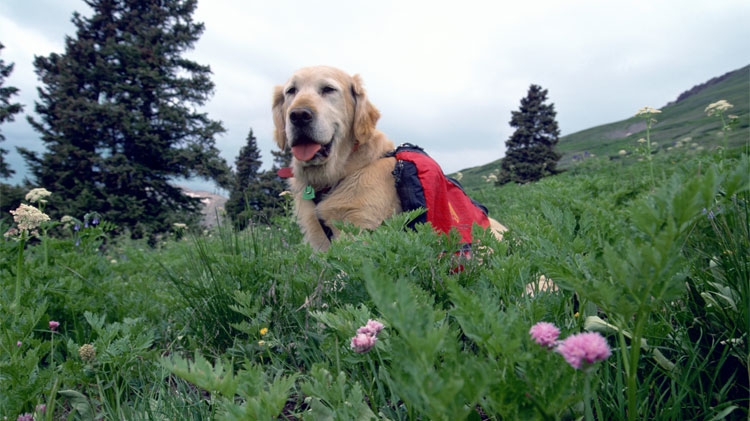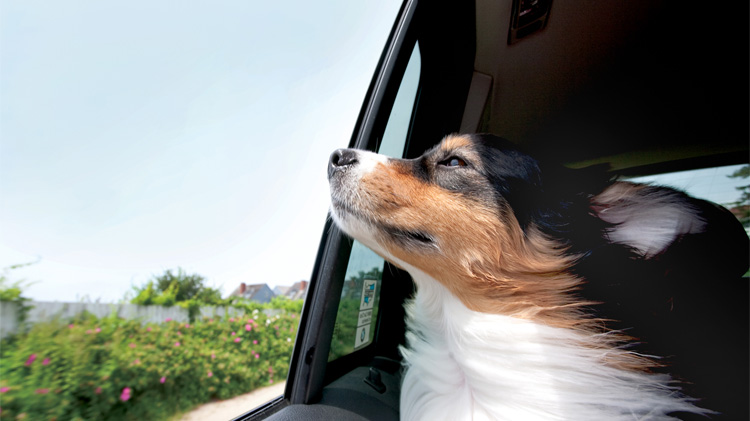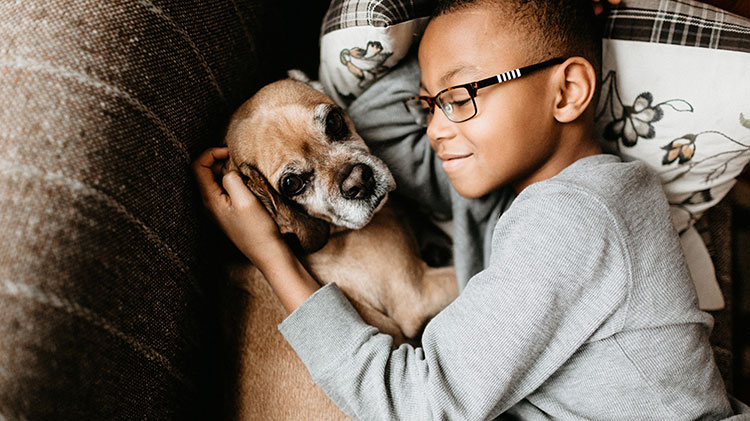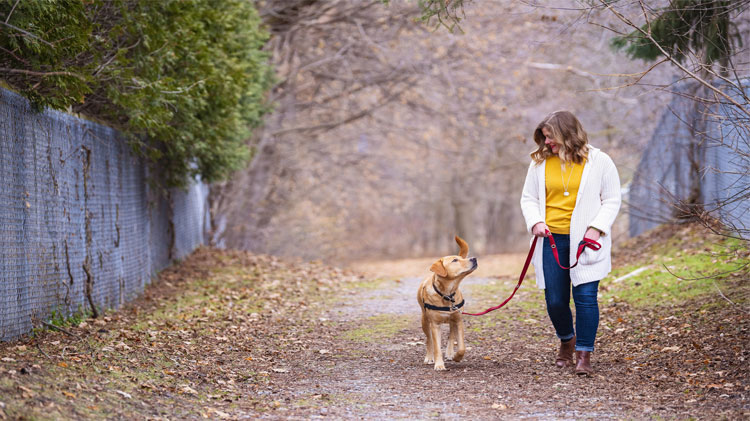How to road trip with dogs or cats
Traveling with a dog or cat? Here are tips to consider when driving with pets.
Whether you're embarking on a cross-country move or hitting the road for some adventure, you may want to bring your beloved cat or dog along for the ride. With careful planning, you can help ensure their comfort and safety. Here are our top tips for a comfortable journey.
Tip #1: Talk to your veterinarian
You know your pet better than anyone, but if you’re thinking about taking a road trip with cats or dogs, it can help to get advice from your veterinarian first. Consider asking important questions such as:
- Is my pet healthy enough to travel? If not, how can they get in tip-top traveling shape?
- Is medication (dog or cat sedation for travel) appropriate? This is especially important if your pet gets anxious, carsick or isn't used to traveling in the car.
- Does my pet have a microchip and updated tags? If you have an indoor cat who doesn't wear a collar, ensure they have a collar and tag for the trip.
- Can you print or email me a copy of my pet's vaccination records and health history? Take these with you on your trip just in case you need to see a veterinarian. This is also a good opportunity to confirm your pet's vaccines are up to date.
Tip #2: Pack all dog or cat essentials
Like kids, traveling with dogs and cats requires a surprising amount of, well... stuff. Luckily, you can find travel-specific pet items that collapse or fold up to take up less space. Traveling with cats and dogs requires some preparation. See that you have these pet essentials:
Consider packing:
- Collapsible food and water bowls
- Extra pet food and bottled water
- Additional cat litter for feline companions
- Poop bags for dogs
- Their favorite toys and treats
- Cold-weather and rain gear for dog walks
- An extra leash for your dog
- A travel pet carrier. If you have a cat, for example, you can find travel cat carriers that have a litter box or enough room for a litter box
- Towels to dry them off (quick-drying towels are even better)
- Pet-specific cleaning supplies
- Paper towels and plastic bags to clean up any messes
- A printed copy of your pet's health history and vaccination records
Bonus tip: Make sure your pet always wears a collar with updated tags — and never let them off leash when outside.
Tip #3: Familiarize your pet with car travel
The more time your pet has to get comfortable with being in a moving car, the better. If your pet isn't used to car travel, take a few weeks (or as much time as you have) to get their paws wet with this new experience.
Our recommendations:
- Take a "mini road trip." Consider taking your cat or dog in the car for a couple of hours at a time and reward them with treats afterwards.
- When you're at home, put out their travel carrier for them to smell, and include treats inside so they can build a positive association with their carrier.
Bonus tip: This step is especially important for cats. You'll want to acclimate them to wearing a collar with tags, using a different litter box (while the car is moving) and maybe even using a harness to go to the bathroom and get exercise. While you may not be able to replicate the ins and outs of a full-on road trip ahead of time, you can take steps to help ensure your cat is familiar with what they'll wear, how they'll do their business and where they'll hang out.
Tip #4: Be mindful of pet safety in cars
We put together some tips on how to drive safely with pets, including how to secure a dog in the car with a leash. Also, try to plan ahead so you never leave your pet alone in the car.
- Call ahead to make sure your stops are pet friendly.
- If you need to leave the car, leave your pet with another adult in the car with A/C running — and see that they have access to plenty of water.
- The AVMA recommends never leaving your pet alone in the car, as temperatures can climb 20 degrees in 10 minutes.
- Just like humans, dogs and cats should buckle up. An unrestrained pet can lead to unsafe driving behaviors, more opportunities to get distracted, and increased stress on both the driver and pet. Never allow your pet to roam unrestrained while you’re driving.
Tip #5: Plan strategic pit stops
Figure out ahead of time where you can stop to take your dog for walks and potty breaks (or give your cat's litter box a nice cleaning). Most rest stops have pet-friendly areas and allow humans a great place to take a bathroom break, too.
Tip #6: Find cat and dog friendly hotels or other pet-friendly accommodations
Where will you stay? A campground? Vacation rental? Hotel? No matter where you catch your zzz's, you'll want to check their pet policies before you book. More specifically, look through their website or call the property and ask:
- Do you allow cats and dogs?
- Do you charge an extra fee for pets? How about for two or more pets?
- Do you have breed restrictions?
- Anything else I should know about your pet policy?
Thankfully, there are more pet-friendly hotels than ever before, as well as dog friendly restaurants and dog friendly beaches where you can stretch your legs.
Bonus tip: If you're planning on staying at a friend or family member's place, make sure their home is cat or dog friendly. For example, if your cat likes to nibble on house plants, ask your friend or family member to place plants in an area your cat can't reach. If they have other pets or kids, see that your pet has a closed-off area of their own.
Tip #7: Give yourself (and your pets) extra time and grace
Our recommendation for planning pet friendly vacations is to build flexibility into your travel plans as much as possible. Trips with pets can be full of surprises, so if you can, plan for extra pit stops, book dog and cat-friendly hotels with no cancellation fees, and pack extra pet supplies, including food and water.
Bonus tip: Expect the unexpected. Pets are experts at the unpredictable, and new and unexpected illnesses and injuries could happen. Before you start your travels, talk to your State Farm® agent about how Trupanion can help protect your pets, or start your free, no-obligation quote online.
Have a safe (and fun!) trip
Your pet is your best friend, your loyal sidekick and now your road-trip partner. With careful planning, you'll help them enjoy — or at least tolerate — life on the road.
